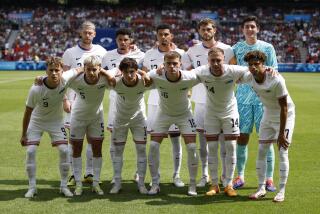WORLD CUP ’90 : Nations Can’t Change Color : * Soccer: It might not be easy to predict goals in the sport’s biggest event, but one can easily predict styles.
To many neophytes, especially Americans, soccer seems an almost endless flow of random motion. It has little of the choreographed quality of U.S. sports.
In baseball and American football, the spectator knows in advance the pattern he is likely to see, but a good soccer game is the instantaneous and intensely cooperative working out of tactics, based on strategic principles, to meet the ever-changing demands of the moment. The teams put their 11 players on the field with a general strategy; all else is improvisation on the run.
For its fans, soccer is the game of games, and its fans number in the hundreds of millions. It is estimated that 500 million people, a tenth of the world’s population, watched the final game of the 1986 World Cup. The world soccer federation, FIFA, is expecting 13.2 billion viewers for the 52 games of this Cup.
World Cup ’90 started two years ago with 110 teams. Now the competition is down to 24--including defending champion Argentina and host nation Italy, which did not have to qualify--and in less than a month the rules of elimination will inexorably cut the contestants to 16, then to eight, then four, then two, and on Sunday night, July 8, the World Cup will be presented to the winner of the single most coveted sports trophy on the planet.
It is remarkable to note how distinctive are the styles of the major powers in soccer. The star players often play in clubs far from their own lands, but when they return to their native teams for the World Cup, they are part and parcel of the national identity.
Post-World War II soccer emphasizes defense, with resulting low scoring. The fascination of the games lies in watching how each team resolves the problem of breaking through the opposition’s defense to strike for those precious goals.
Latin American teams tend to be very fluid, very enthusiastic, with lots of passing. The Europeans tend to be both more methodical and more physical.
The Soviet Union, whose political and economic drama now grips the world’s attention, is among the 24 teams in Italy. But the Soviets have never even made it to the semifinals. The conclusion is inescapable: heavily bureaucratized societies produce stereotyped planning that is inimical to the spontaneous creativity absolutely necessary for effective play.
The most spectacular team historically has been Brazil.
It is commonly said that everybody’s second-favorite team is Brazil. In Brazil itself, of course, the gross national product stops dead when the team’s games are shown on television. When those yellow shirts go on attack--which is most of the time--and the fans cheer to the intoxicating beat of the samba bands, the sheer joy of Brazilian soccer sweeps up all those who love the fluidity, the imagination of the game.
The drawbacks of Brazilian soccer are excessive emphasis on offense and too much devotion to technique.
It is reported that this year the Brazilians have a superior goalie in Claudio Taffarel. He would be the first Brazilian defensive player of renown in a very long time, perhaps since 1958. Traditionally, Brazil and defense have not been associated with one another.
Perhaps the goalie’s job is too lonely for Brazilians, for he must stand there waiting while his teammates dazzle with their intricate runs and passes. Perhaps defense is not a characteristic the Brazilian sense of identity cares to contemplate.
In any case, it will be interesting to see if, in this tournament, the Brazilian style is modified, if indeed, as some predict, it will become more European.
The Argentine team, the defending champion whose captain Diego Maradona was the star of the 1986 World Cup in Mexico and is one of the men to watch in Italy, is like the country it represents--either utterly flat or absolutely inspired. When the Argentine players are off, they’re a mess. They seem to lose interest. Nothing goes right.
But when they’re on, as they showed four years ago, they’re brilliant. They play with the kind of exuberance and flair associated with Brazil, but they’re more deadly. They don’t waste as much time as the Brazilians do on exuberant technique.
Italy could well be very good in this cup. It has the advantage of playing before its own fans in its own country. Its team seemed young two years ago in the European Championships, but it has shown some promise of adopting more imaginative tactics. If the Italians can master their newly acquired offensive skills, they could go to the final.
The Italian traditional national style husbands its energy for the main task. It has habitually attempted to force its opponent out of his own game plan and to impose its own. In this the traditional Italian style is somewhat Machiavellian: It spends the first half wearing out its opponents. But the style has become too rigid for the modern game.
Toughness and discipline mark the West German game, and perseverance is what West Germany will need in Italy, every step of the way. It is a truism that the West German team plans its games as the German general staff has always planned its: with meticulous attention to detail. But both suffer when, under the pressure of events, they are forced to deal with contingencies that overwhelm their intricate planning and put tremendous psychological pressure on the contenders.
In soccer, it does not help the national team that the German press is merciless toward what it regards as failure.
The West German team, lacking great imagination, will have to fight for every victory. By the end of the tournament it may be psychically exhausted. But it has nonetheless a high chance of success. Its coach, Franz Beckenbauer, is one of the all-time greats in soccer. He is a master tactician.
The most interesting pairing in the early rounds will be that between England and the Netherlands on June 16 in Cagliari on the island of Sardinia. Both countries have groups of brawling hooligans among their fans. They have been assigned to the island not only because of the relative ease of controlling the vandals, but also because it is thought the local population is tough enough to take care of them.
England, the dominant soccer power before World War II and for a decade after, has gradually declined. It is steady, reliable, tough, but it has, until now anyway, been unwilling to adapt its traditional game to the passing game needed to break open the modern defense. Nevertheless, it has been playing well most of the time for the past couple of years. Everyone who enjoys England’s muscular game hopes for its success.
Given the Netherlands’ small population, it is hard to explain why the Dutch team is so outstanding. It was runner-up in the 1974 and 1978 World Cups and won the European championship 1988. The Dutch are probably the most beautiful European team to watch, and they have two of Europe’s best players: Marco Van Basten and Ruud Gullit. The problem with the Dutch is that they tend to wear out over four weeks of play; they don’t have the reserves.
The Americans have the disability that they do not play in the major soccer leagues, and they don’t have any major competitors. The American team will do well to score a few goals. Americans can take pride that their team has made it this far.
Nobody in his right mind would dare to pick the winner of the final game on July 8.
We will, however, be bold enough to predict that the four teams in the semifinals will be Brazil, Italy, West Germany, then the Netherlands or England, whichever proves stronger, with Uruguay as a dark horse.






